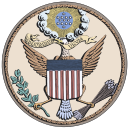
Back Illinois durant la guerre de Sécession French Иллинойс в Гражданской войне Russian Illinois under amerikanska inbördeskriget Swedish
 |
|
Union states in the American Civil War |
|---|
|
|
| Dual governments |
| Territories and D.C. |
During the American Civil War, the state of Illinois was a major source of troops for the Union Army (particularly for those armies serving in the Western Theater of the Civil War), and of military supplies, food, and clothing. Situated near major rivers and railroads, Illinois became a major jumping off place early in the war for Ulysses S. Grant's efforts to seize control of the Mississippi and Tennessee rivers. Statewide, public support for the Union was high despite Copperhead sentiment.
The state was energetically led throughout the war by Governor Richard Yates. Illinois contributed 250,000 soldiers to the Union Army, ranking it fourth in terms of the total manpower in Federal military service. Illinois troops predominantly fought in the Western Theater, although a few regiments played important roles in the East, particularly in the Army of the Potomac. Several thousand Illinoisians were killed or died of their wounds during the war, and a number of national cemeteries were established in Illinois to bury their remains. In addition to President Abraham Lincoln, a number of other Illinois men became prominent in the army or in national politics, including generals, Ulysses S. Grant, John M. Schofield and John A. Logan, Senator Lyman Trumbull, and Representative Elihu P. Washburne. No major battles were fought in the state, although several river towns became sites for important supply depots and "brownwater" navy yards. Several prisoner of war camps and prisons dotted the state after 1863, processing thousands of captive Confederate soldiers.
However, not everyone in the state supported the war. In fact, there were even calls for secession in Southern Illinois or Little Egypt by several residents. In Marion residents voted to secede from the United States. A few, even, volunteered for the Confederate States Army in Tennessee. Thirty-four men, while Frank Metcalf claimed they were forty-five,[1] from the southern tip of the state, were recruited from Jackson and Williamson County, joined Company G, "The Illinois Company", of the 15th Tennessee Regiment Volunteer Infantry.[2] This can be attributed to the region's close cultural and economic ties to the South since many Southerners had migrated there. However, the movement for secession soon fizzled after the proposal was blocked and shelved.
Eighteen counties of southern Illinois formed the congressional district of Democrat John A. Logan. Rumors abounded in early 1861 whether he would organize his supporters and join the Confederacy. In fact he was suppressing pro-Confederate elements, and organizing his supporters to fight for the Union. Lincoln made him a general, and Logan played a major role under generals Grant and Sherman. His men marched to war as Democrats; they marched home as Republicans. Later, Logan helped found the Grand Army of the Republic veteran organization, was elected to the United States Senate as a Republican, and was the Republican vice presidential nominee in 1884.[3][4] As a precaution, Union troops remained in Little Egypt for the remainder of the war.[5] Confederate sentiment would remain alive in Southern Illinois amid the growing Copperhead political movement in the North.
- ^ Metcalf, Frank. "The Illinois Confederate Company," Confederate Veteran, vol. 16, pp.224-5. S.A. Cunningham, 1908.
- ^ 15th Tennessee Volunteer Infantry - Company G, The Confederate Army's Southern Illinois Company, Illinois in the Civil War website
- ^ William S. Morris; et al. (1998). History 31st Regiment Illinois Volunteers Organized by John A. Logan. SIU Press. pp. 15–20.
- ^ James Pickett Jones (1995). Black Jack: John A. Logan and Southern Illinois in the Civil War Era. SIU Press. pp. 82–90.
- ^ "The Civil War and Late 19th Century" Archived 2012-02-23 at the Wayback Machine, The History of Southern Illinois, Egyptian Area on Aging, Inc., 1996–2009, accessed 15 May 2009
© MMXXIII Rich X Search. We shall prevail. All rights reserved. Rich X Search